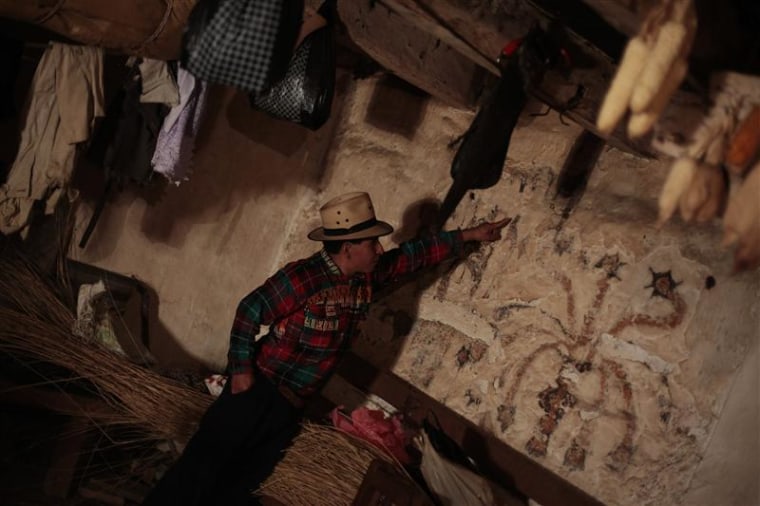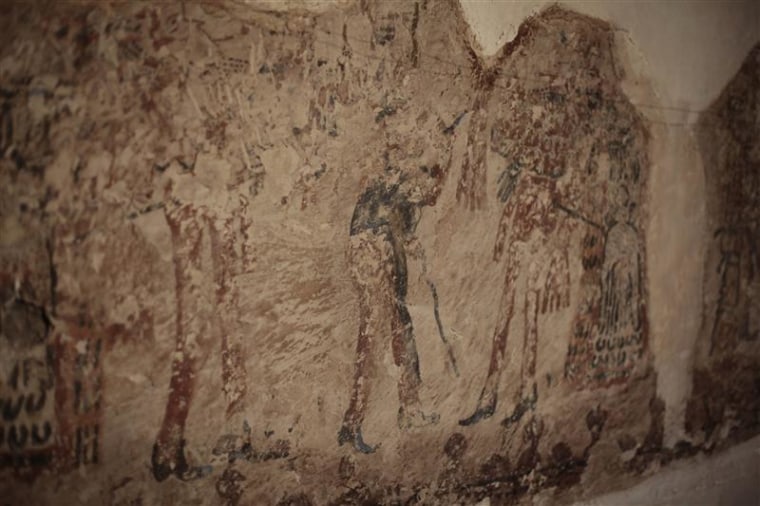In a ramshackle home in Guatemala's rural highlands, farmer and odd job man Lucas Asicona made for an unlikely guardian of ancient Mayan treasures — until he decided to redo his kitchen.
When he pulled back the plaster in his humble colonial-era home of stone, adobe and haphazard wooden boards, he discovered 300-year-old murals, a priceless piece of Guatemalan history.
Scenes of tall Europeans beating drums and playing flutes stare out over the one-room dwelling where his family including five children cooked, slept and played.
So he carefully drew back the furniture and moved his wood burning kitchen stove outside to protect the treasured artwork, an informal curator of Guatemala's rich past.
"We try to keep the kids away from it and keep people from touching it," said Asicona, 38, who discovered the murals by chance in 2005 during renovation work at his home, which has been in his family for generations.
"The house is very humid and some of the colors have been fading. The black has started to turn gray and some of the other colors have lost their shine, but we do what we can without any funding," he added.
Asicona is among four householders in Chajul, an Ixil Maya community some 220 miles from Guatemala City, struggling to preserve murals revealed after peeling back plaster on the walls of ancient homes. Experts believe similar murals could lie hidden in a further eight homes in the town.
Painted by the current occupants' Mayan ancestors, the friezes cover several walls of the homes, whose colonial history is glimpsed in details including heavy hardwood doors and carved stone pillars propping up modern tin roofs.
The murals provide a unique visual record of the moment in history when the local Maya — some depicted in plumed costumes — encountered the tall, bearded conquistadors from Spain who tried to convert them to Christianity.

Historians says the murals peeping through the plaster at Asicona's home illustrate the so-called "conquest dance," from a time in the 1650s when Spaniards forced locals to build a Catholic Church which still stands at the center of town.
Other paintings in a neighbor's home show spiraling fireballs that local lore says fell from the sky at the height of the colonial encounter in the 17th century and were thought by the Maya to be a sign of anger from the gods.
"We consider these murals to be very unique," Guatemalan anthropologist Ivonne Putzeys said of the trove found in the pine-ringed highland town. "It's tangible heritage that represent real scenes from history."
'Doing the best we can'
Mayan civilization thrived between AD 250 and 900 and extended from modern day Honduras to central Mexico. It left behind a trove of pyramids and dozens of distinct Mayan groups who continue to endure.
Around half of Guatemala's 14.5 million people are of indigenous descent, many of whom continue to speak 21 officially recognized languages and wear brightly colored traditional dress.
Historians in Chajul say conserving the rich pictorial heritage is vital for the town of 25,000 people, which was settled four centuries ago by Mayan groups who fled Spanish settlers in Antigua, a few miles (kms) from Guatemala City.
"Throughout our history, our people painted these murals so that their stories wouldn't be forgotten," said historian Felipe Rivera.
But in a country where more than half the population live in poverty, conservation is proving a challenge.
Asicona said he last contacted the government for help in 2007 but never received a response. Like other families, he says he is simply doing his best to conserve the friezes.
After making the discovery, Asicona swiftly made repairs to his home to prevent leaks during the country's soggy rainy season and pushed the family's beds to opposite walls where his kids jump up and down.
Cabinets have been moved to the center of the room in order to keep dust from dirtying the murals.
He has received visitors from as far away as Europe who have paid up to $10 dollars to come in and see the paintings, but without more support he worries that the prized artwork could disappear.
"We keep the house up as best we can," he said. "We have contacted the government about the paintings, but (all we get are) promises and no action."
Culture Ministry spokesman Sergio Igax said that for the families to receive funding to preserve the murals, the homes have to be declared national heritage — a long process that involves lots of paperwork.
He said the ministry had not received a request from Chajul for an evaluation in recent years.
(Editing by Tim Gaynor, Simon Gardner and Cynthia Osterman)
